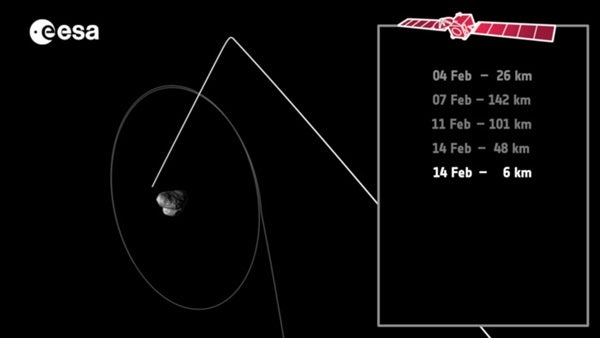Yesterday was Rosetta’s last day at 16 miles (26km) from Comet 67P/Churyumov–Gerasimenko, marking the end of the current orbiting period and the start of a new phase for the rest of this year.
Today, Rosetta is moving into a new path ahead of a close encounter next week. First, it will move out to a distance of roughly 87 miles (140km) from the comet by February 7, before swooping in for the close encounter at 12:41 GMT (13:41 CET) February 14. The closest pass occurs over the comet’s larger lobe, above the Imhotep region.
“The upcoming close flyby will allow unique scientific observations, providing us with high-resolution measurements of the surface over a range of wavelengths and giving us the opportunity to sample — taste or sniff — the very innermost parts of the comet’s atmosphere,” said Matt Taylor from ESA.
The flyby will take Rosetta over the most active regions of the comet, helping scientists understand the connection between the source of the observed activity and the atmosphere, or coma.
In particular, they will be looking for zones where the outflowing gas and dust accelerates from the surface and how these constituents evolve at larger distances from the comet.
The comet’s surface is already known to be very dark, reflecting just 6 percent of the light that falls on it. During the close flyby, Rosetta will pass over the comet with the Sun directly behind, allowing shadow-free images to be collected. By studying the reflectivity of the nucleus as it varies with the angle of the sunlight falling on it, scientists hope to gain a more detailed insight into the dust grains on the surface.
“After this close flyby, a new phase will begin when Rosetta will execute sets of flybys past the comet at a range of distances between about 15km [9 miles] and 100km [60 miles],” said Sylvain Lodiot from ESA.
It was always planned to change from “bound orbits” to flyby trajectories at this point in the mission, based on predictions of increasing cometary activity. The range of flyby distances also balances the various needs of Rosetta’s 11 instruments in order to optimize the mission’s scientific return.
During some of the close flybys, Rosetta will encounter the comet almost in step with the rotation, allowing the instruments to monitor a single point on the surface as it passes by.
Meanwhile, the more distant flybys will provide the broader context of a wide-angle view of the nucleus and its growing coma.
“We’re in the main science phase of the mission now, so throughout the year we’ll be continuing with high-resolution mapping of the comet,” said Taylor.
“We’ll sample the gas, dust, and plasma from a range of distances as the comet’s activity increases and then subsides again later in the year.”
Perihelion, closest approach to the Sun, occurs August 13 when the comet and Rosetta will be 116 million miles (186 million km) from the Sun, between the orbits of Earth and Mars.
In the month before perihelion, as activity is reaching a peak, the team is planning to study one of the comet’s jets in greater detail than ever before.
“We hope to target one of these regions for a fly-through, to really get a taste of the outflow of the comet,” said Taylor.
After perihelion and once the comet’s activity begins to subside, the mission team will determine if and when to return to a bound orbit around the comet and how long Rosetta might be able to operate beyond the end of 2015.










